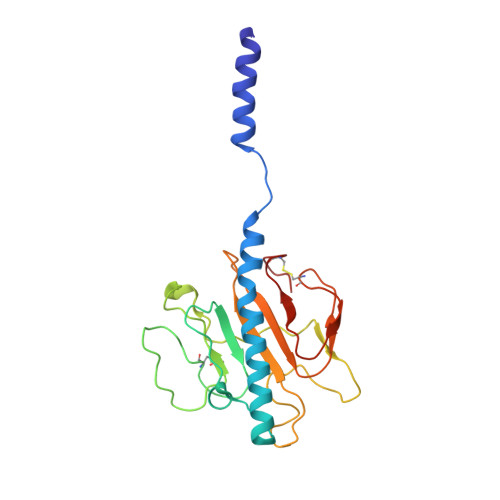Tight-packing of large pilin subunits provides distinct structural and mechanical properties for the Myxococcus xanthus type IVa pilus.
Treuner-Lange, A., Zheng, W., Viljoen, A., Lindow, S., Herfurth, M., Dufrene, Y.F., Sogaard-Andersen, L., Egelman, E.H.(2024) Proc Natl Acad Sci U S A 121: e2321989121-e2321989121
- PubMed: 38625941
- DOI: https://doi.org/10.1073/pnas.2321989121
- Primary Citation of Related Structures:
8TJ2 - PubMed Abstract:
Type IVa pili (T4aP) are ubiquitous cell surface filaments important for surface motility, adhesion to surfaces, DNA uptake, biofilm formation, and virulence. T4aP are built from thousands of copies of the major pilin subunit and tipped by a complex composed of minor pilins and in some systems also the PilY1 adhesin. While major pilins of structurally characterized T4aP have lengths of <165 residues, the major pilin PilA of Myxococcus xanthus is unusually large with 208 residues. All major pilins have a conserved N-terminal domain and a variable C-terminal domain, and the additional residues of PilA are due to a larger C-terminal domain. We solved the structure of the M. xanthus T4aP (T4aP Mx ) at a resolution of 3.0 Å using cryo-EM. The T4aP Mx follows the structural blueprint of other T4aP with the pilus core comprised of the interacting N-terminal α1-helices, while the globular domains decorate the T4aP surface. The atomic model of PilA built into this map shows that the large C-terminal domain has more extensive intersubunit contacts than major pilins in other T4aP. As expected from these greater contacts, the bending and axial stiffness of the T4aP Mx is significantly higher than that of other T4aP and supports T4aP-dependent motility on surfaces of different stiffnesses. Notably, T4aP Mx variants with interrupted intersubunit interfaces had decreased bending stiffness, pilus length, and strongly reduced motility. These observations support an evolutionary scenario whereby the large major pilin enables the formation of a rigid T4aP that expands the environmental conditions in which the T4aP system functions.
- Department of Ecophysiology, Max Planck Institute for Terrestrial Microbiology, Marburg 35043, Germany.
Organizational Affiliation:
















